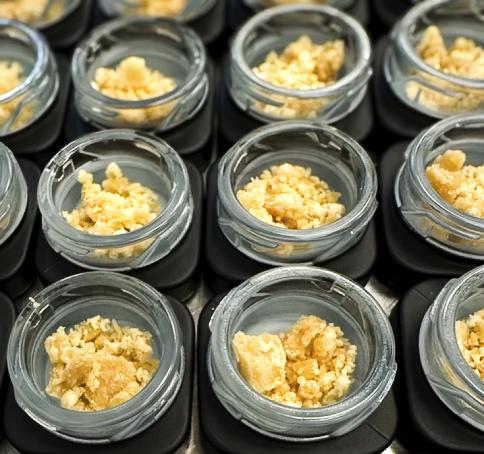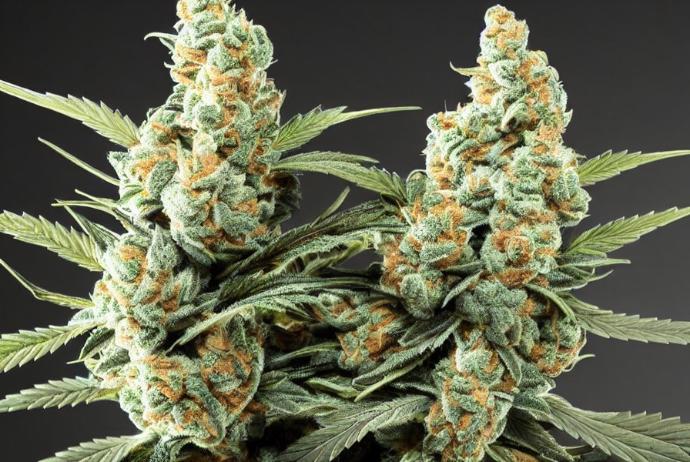Introduction
Cannabinol, or CBN, is a cannabinoid that offers a unique profile distinct from the more widely known compounds such as THC and CBD. Originating from the cannabis plant, CBN is typically produced as THC degrades over time, often due to environmental factors like light and heat. This cannabinoid has started to capture the attention of both the consumer market and the scientific community due to its distinct characteristics and the evolving understanding of its presence in aged cannabis.
Unlike THC, which is synthesized actively by the cannabis plant, CBN's formation is a passive process that occurs as the plant material ages. This process of degradation not only alters the chemical composition of the cannabis but also modifies its potential uses and effects. As a result, CBN is often found in older cannabis and is influenced by the storage and curing processes of the plant.
The interest in CBN has grown as researchers and consumers alike seek to understand and leverage the diverse compounds produced by the cannabis plant. While it does not share the high psychoactivity of THC, CBN has become notable for its mild psychoactive effects, which are typically less intense than those of THC. This characteristic makes CBN a subject of interest for those looking to explore the benefits of cannabis without the strong psychoactive outcomes.
As the cannabis industry continues to mature, the nuances of different cannabinoids like CBN are becoming more significant. Consumers are increasingly interested in personalized cannabis experiences, driving demand for specific cannabinoids that can offer distinct effects. This shift towards more tailored options highlights the importance of understanding each cannabinoid's unique properties and potential contributions to both recreational and product-driven applications.
What is CBN?
CBN, or Cannabinol, emerges as a fascinating component of the cannabis plant. It is primarily known for its status as a derivative formed through the oxidation of THC, the cannabinoid famous for its psychoactive properties. This transformation occurs when THC is exposed to air and light over time, leading to the breakdown of THC and the formation of CBN. This process underscores the significance of storage conditions in preserving cannabis and its various compounds.
The formation of CBN from THC introduces subtle complexities to the aging process of cannabis. As the plant matures or undergoes prolonged exposure to environmental factors, its cannabinoid profile changes, potentially enhancing certain characteristics while diminishing others. This natural progression from THC to CBN highlights the dynamic nature of cannabis and its compounds, which can alter in potency and effect based on numerous factors.
CBN's chemical structure allows it to interact with the body’s cannabinoid receptors, albeit differently than THC. Its interaction is noted for being milder compared to the more robust effects of THC. This distinction is crucial for users who seek specific experiences from cannabis products, particularly those looking for alternatives that do not produce strong psychoactive effects.
Understanding the chemistry and behavior of CBN not only enriches our appreciation of cannabis’s complexity but also opens up new avenues for exploring its applications. The transformation of THC into CBN serves as a natural experiment in cannabinoid evolution, offering insights into the lifecycle of cannabis compounds and their shifting roles as the plant ages.
How is CBN Produced?
CBN production is a fascinating result of the natural aging process in cannabis. As THC degrades, primarily through exposure to oxygen and ultraviolet light, it undergoes a chemical transformation into CBN. This process is a classic example of how time and environmental factors can alter the chemical makeup of the cannabis plant.
The production of CBN is significantly influenced by the conditions under which cannabis is stored. Exposure to air (oxygen), light, and higher temperatures can accelerate the conversion of THC to CBN. This is why cannabis storage practices are critical for maintaining the desired cannabinoid profile, especially for cultivators and consumers looking to manage the levels of specific cannabinoids like CBN.
Controlled degradation techniques can also be employed to increase the CBN content in cannabis intentionally. For instance, curing cannabis at specific temperatures and controlled exposure to light can optimize the conversion process from THC to CBN, creating products with higher CBN concentrations. This methodical approach allows producers to cater to a niche market that prefers CBN’s attributes.
The transformation from THC to CBN not only demonstrates the adaptability and complexity of cannabis compounds but also the potential for tailored cannabinoid production through post-harvest techniques. Understanding these processes is crucial for both cultivators aiming to enhance specific cannabinoid profiles and for consumers interested in the implications of cannabis aging.
Methods of Consuming CBN
CBN is available in various forms, catering to diverse preferences and needs, much like other cannabinoids. The different methods of consumption offer users flexibility in how they experience CBN, depending on their lifestyle and consumption goals.
- Edibles: CBN-infused edibles are a popular choice for those seeking a convenient and discreet method of consumption. These can range from gummies and chocolates to beverages, all of which provide a controlled dosage of CBN. Edibles are favored for their ease of use and the prolonged experience they offer, which can vary based on the product's formulation and the individual's metabolism.
- Tinctures: CBN tinctures are another versatile option, consisting of CBN dissolved in a carrier oil. Tinctures are typically administered sublingually (under the tongue), allowing for quick absorption into the bloodstream. Users can also add tinctures to foods or beverages for a more gradual effect as they are digested.
- Capsules: For those who prefer precise dosages and a no-fuss approach, CBN capsules are ideal. Each capsule contains a specific amount of CBN, making it easy to monitor consumption and maintain consistency with usage.
- Vapes: Vaping CBN oil is a method favored for its rapid onset of effects. The inhaled vapor enters the lungs and is quickly absorbed into the bloodstream, making it a preferred choice for users looking for immediate results.
Each of these consumption methods offers its own set of advantages, depending on the user’s needs and circumstances. Whether looking for quick relief or a prolonged effect, the diverse array of CBN products provides suitable options for various preferences. As the market continues to expand, the availability of innovative CBN products is likely to grow, offering even more tailored ways to experience this unique cannabinoid.
Legal Status of CBN
The legal status of CBN is an evolving topic that closely mirrors the regulations surrounding other cannabinoids derived from cannabis. Understanding the legal framework for CBN is crucial for both consumers and businesses operating in the cannabis industry.
In regions where cannabis has been legalized for medical or recreational use, CBN is generally included under the same regulatory frameworks. This means that in places like certain states in the USA, Canada, and parts of Europe where cannabis is legal, CBN products are also legal and are subject to similar laws governing production, distribution, and sale.
However, the legal landscape can be quite different in areas where cannabis remains illegal. In such regions, any compounds derived from cannabis, including CBN, might also be restricted. The legality of CBN in these areas often depends on how it is sourced. For instance, CBN derived from hemp (cannabis with a THC content of less than 0.3%) may be legal under certain jurisdictions that have legalized hemp and hemp-derived products.
It's important for consumers and industry stakeholders to stay informed about the local cannabis laws affecting CBN. As cannabis legislation continues to change around the world, the status of CBN could shift, impacting how it can be marketed, sold, or used. Businesses involved in the production and sale of CBN products must navigate these regulations carefully to ensure compliance, while consumers should be aware of the legality of these products in their specific locations to avoid legal issues.
Recreational Use of CBN
CBN is gaining popularity in the recreational cannabis market due to its unique characteristics among cannabinoids. While it is less psychoactive than THC, CBN offers a distinct experience that many users find desirable for relaxation and leisure activities.
As a milder alternative to THC, CBN is appealing to users who seek a less intense effect from their cannabis consumption. This attribute makes it suitable for evening use or for those who prefer a subtle impact, enhancing relaxation without the potent high associated with THC. Recreational users often explore CBN in various forms, such as edibles and vapes, to enjoy its qualities in a manner that best suits their lifestyle and preferences.
The interest in CBN for recreational purposes also extends to its use in combination with other cannabinoids and terpenes. Many users and producers are interested in the entourage effect, where combining multiple cannabis compounds may lead to a more enjoyable and nuanced experience. Products that incorporate a blend of CBN, CBD, and terpenes are becoming more common, catering to consumers looking to experiment with their personal cannabis experience.
As CBN becomes more accessible through legal cannabis markets, its presence in recreational products is likely to increase. This expansion reflects a growing appreciation for the diverse effects of cannabinoids and the desire among recreational users to tailor their cannabis experience to fit their individual needs and situations.
Perspectives on CBN
Advocates
- Supporters of CBN are enthusiastic about its distinct properties and the diversity it adds to the cannabis product spectrum. Advocates include both consumers who enjoy its milder effects and industry professionals who see potential in expanding cannabis product offerings. They often promote further research into CBN and advocate for deregulation to facilitate greater access and innovation within the cannabis market. Advocates believe that expanded research and consumer knowledge will lead to a broader acceptance and understanding of CBN’s unique place within the array of cannabis products.
Skeptics
- On the other hand, some remain cautious about the rapid commercialization of CBN due to the relatively sparse research compared to more studied cannabinoids like CBD and THC. Skeptics call for more controlled, scientific studies to better understand the full range of CBN's effects and interactions. They emphasize the need for a careful approach that ensures consumers are well-informed and protected, arguing that robust scientific validation is crucial before making any definitive claims about its benefits or safety.
Researchers
- The scientific community is particularly interested in deepening the understanding of CBN’s characteristics and its potential role within the broader pharmacology of cannabis. Researchers are exploring the molecular pathways through which CBN interacts with the body’s cannabinoid receptors, as well as its behavior in conjunction with other cannabinoids. This growing body of research is critical not only for validating the experiences reported by users but also for guiding future applications of CBN in the cannabis industry.
CBN is gradually carving out its niche within the diverse world of cannabis, supported by a growing base of enthusiasts who appreciate its subtler effects. As research progresses and consumer interest increases, the conversation around CBN is likely to evolve, potentially leading to new innovations and applications that could reshape its role in the market. The ongoing dialogue among advocates, skeptics, and researchers will play a key role in shaping the future landscape of CBN usage.
The Future of CBN
As the cannabis industry continues to mature and consumer preferences evolve, the role of CBN is expected to expand significantly. This expansion is driven by both advancements in cannabis research and the growing demand for a wider variety of cannabinoid-based products.
Market Trends and Consumer Demand
The increasing sophistication of consumers, who are becoming more educated about the nuances of different cannabinoids, is driving demand for products containing CBN. As users seek tailored experiences that fit their specific needs and preferences, CBN's unique attributes make it a valuable addition to the array of products available in dispensaries. This trend is supported by a shift towards more personalized cannabis consumption, where users are not just seeking the psychoactive effects of THC but are interested in the broader spectrum of experiences that other cannabinoids like CBN can offer.
Technological and Product Innovation
Technological advancements in extraction and synthesis techniques are making it easier and more cost-effective to isolate and study cannabinoids like CBN. As these technologies improve, producers can create purer, more consistent CBN products, ranging from tinctures and topicals to edibles and capsules. This innovation extends to the development of new formulations that combine CBN with other cannabinoids and terpenes to leverage the entourage effect for more complex and nuanced products.
Regulatory Landscape
The legal landscape surrounding cannabis and its derivatives continues to evolve. As more regions consider the legalization and regulation of cannabis, the status of CBN is also likely to change. Regulatory clarity will be crucial in defining the scope of CBN's market potential, influencing everything from cultivation and production to marketing and sales. As regulations become more standardized, the market for CBN and other cannabinoids is expected to become more accessible and robust.
Conclusion
CBN, or Cannabinol, represents a growing area of interest within the dynamic landscape of cannabis compounds. Its emergence from the shadows of more prominent cannabinoids like THC and CBD highlights a broader trend towards the exploration and appreciation of the less understood components of the cannabis plant.
Broader Implications for the Cannabis Industry
As the industry continues to innovate and respond to consumer demand, CBN is set to become a key element in the development of new cannabis products. This interest is fueled by the cannabinoid's unique characteristics and the potential for creating more diverse and refined consumer experiences. The expanding knowledge about CBN, coupled with advancements in cannabis science and product development, points towards a future where each cannabinoid is valued for its specific contribution to the cannabis experience.
Consumer Education and Awareness
With the growing complexity of the cannabis market, consumer education becomes increasingly important. As CBN gains popularity, efforts to educate consumers on its properties, effects, and legal status will play a vital role in shaping its market presence. Well-informed consumers are better equipped to make choices that align with their preferences and needs, driving demand for products that incorporate cannabinoids like CBN in meaningful ways.
Looking Forward
The trajectory of CBN's development and integration into the market is likely to mirror the broader trends affecting the cannabis industry, including regulatory changes, scientific advancements, and evolving consumer preferences. As part of this dynamic field, CBN's journey from a minor, little-understood component to a significant player in the cannabis narrative is emblematic of the maturation of the cannabis industry as a whole.






















